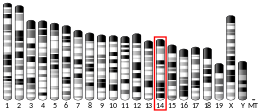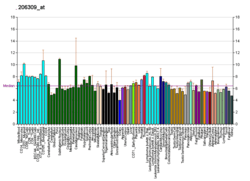LECT1
Chondromodulin-1 is a protein that in humans is encoded by the LECT1 gene.[5][6][7]
| CNMD | |||||||||||||||||||||||||
|---|---|---|---|---|---|---|---|---|---|---|---|---|---|---|---|---|---|---|---|---|---|---|---|---|---|
| Identifiers | |||||||||||||||||||||||||
| Aliases | CNMD, BRICD3, CHM-I, CHM1, MYETS1, LECT1, leukocyte cell derived chemotaxin 1, chondromodulin | ||||||||||||||||||||||||
| External IDs | OMIM: 605147 MGI: 1341171 HomoloGene: 5095 GeneCards: CNMD | ||||||||||||||||||||||||
| |||||||||||||||||||||||||
| |||||||||||||||||||||||||
| |||||||||||||||||||||||||
| Orthologs | |||||||||||||||||||||||||
| Species | Human | Mouse | |||||||||||||||||||||||
| Entrez | |||||||||||||||||||||||||
| Ensembl | |||||||||||||||||||||||||
| UniProt | |||||||||||||||||||||||||
| RefSeq (mRNA) | |||||||||||||||||||||||||
| RefSeq (protein) | |||||||||||||||||||||||||
| Location (UCSC) | Chr 13: 52.7 – 52.74 Mb | Chr 14: 79.64 – 79.66 Mb | |||||||||||||||||||||||
| PubMed search | [3] | [4] | |||||||||||||||||||||||
| Wikidata | |||||||||||||||||||||||||
| |||||||||||||||||||||||||
Function
This gene encodes a glycosylated transmembrane protein that is cleaved to form a mature, secreted protein. The N-terminus of the precursor protein shares characteristics with other surfactant proteins and is sometimes called chondrosurfactant protein, although no biological activity has yet been defined for it. The C-terminus of the precursor protein contains a 25 kDa mature protein called leukocyte cell-derived chemotaxin-1 or chondromodulin-1. The mature protein promotes chondrocyte growth and inhibits angiogenesis. This gene is expressed in the avascular zone of prehypertrophic cartilage, and its expression decreases during chondrocyte hypertrophy and vascular invasion. The mature protein likely plays a role in endochondral bone development by permitting cartilaginous anlagen to be vascularized and replaced by bone. It may also be involved in the broad control of tissue vascularization during development. Alternative splicing results in multiple transcript variants encoding different isoforms.[7]
References
- GRCh38: Ensembl release 89: ENSG00000136110 - Ensembl, May 2017
- GRCm38: Ensembl release 89: ENSMUSG00000022025 - Ensembl, May 2017
- "Human PubMed Reference:". National Center for Biotechnology Information, U.S. National Library of Medicine.
- "Mouse PubMed Reference:". National Center for Biotechnology Information, U.S. National Library of Medicine.
- Shukunami C, Hiraki Y (August 1998). "Expression of cartilage-specific functional matrix chondromodulin-I mRNA in rabbit growth plate chondrocytes and its responsiveness to growth stimuli in vitro". Biochemical and Biophysical Research Communications. 249 (3): 885–90. doi:10.1006/bbrc.1998.9233. PMID 9731231.
- Hiraki Y, Mitsui K, Endo N, Takahashi K, Hayami T, Inoue H, Shukunami C, Tokunaga K, Kono T, Yamada M, Takahashi HE, Kondo J (March 1999). "Molecular cloning of human chondromodulin-I, a cartilage-derived growth modulating factor, and its expression in Chinese hamster ovary cells". European Journal of Biochemistry / FEBS. 260 (3): 869–78. doi:10.1046/j.1432-1327.1999.00227.x. PMID 10103018.
- "Entrez Gene: LECT1 leukocyte cell derived chemotaxin 1".
Further reading
- Hiraki Y, Shukunami C (July 2000). "Chondromodulin-I as a novel cartilage-specific growth-modulating factor". Pediatric Nephrology. 14 (7): 602–5. doi:10.1007/s004670000339. PMID 10912526.
- Hayami T, Shukunami C, Mitsui K, Endo N, Tokunaga K, Kondo J, Takahashi HE, Hiraki Y (September 1999). "Specific loss of chondromodulin-I gene expression in chondrosarcoma and the suppression of tumor angiogenesis and growth by its recombinant protein in vivo". FEBS Letters. 458 (3): 436–40. doi:10.1016/S0014-5793(99)01201-6. PMID 10570955.
- Yanagihara I, Yamagata M, Sakai N, Shukunami C, Kurahashi H, Yamazaki M, Michigami T, Hiraki Y, Ozono K (March 2000). "Genomic organization of the human chondromodulin-1 gene containing a promoter region that confers the expression of reporter gene in chondrogenic ATDC5 cells". Journal of Bone and Mineral Research. 15 (3): 421–9. doi:10.1359/jbmr.2000.15.3.421. PMID 10750556.
- Azizan A, Holaday N, Neame PJ (June 2001). "Post-translational processing of bovine chondromodulin-I". The Journal of Biological Chemistry. 276 (26): 23632–8. doi:10.1074/jbc.M009967200. PMID 11323410.
- Aoyama T, Okamoto T, Nagayama S, Nishijo K, Ishibe T, Yasura K, Tsuboyama T, Nakayama T, Nakashima Y, Nakamura T, Toguchida J (February 2004). "Expression of the chondromodulin-I gene in chondrosarcomas". Cancer Letters. 204 (1): 61–8. doi:10.1016/j.canlet.2003.09.015. hdl:2433/147532. PMID 14744535.
- Aoyama T, Okamoto T, Nagayama S, Nishijo K, Ishibe T, Yasura K, Nakayama T, Nakamura T, Toguchida J (July 2004). "Methylation in the core-promoter region of the chondromodulin-I gene determines the cell-specific expression by regulating the binding of transcriptional activator Sp3". The Journal of Biological Chemistry. 279 (27): 28789–97. doi:10.1074/jbc.M401273200. PMID 15107420.
- Yoshioka M, Yuasa S, Matsumura K, Kimura K, Shiomi T, Kimura N, Shukunami C, Okada Y, Mukai M, Shin H, Yozu R, Sata M, Ogawa S, Hiraki Y, Fukuda K (October 2006). "Chondromodulin-I maintains cardiac valvular function by preventing angiogenesis". Nature Medicine. 12 (10): 1151–9. doi:10.1038/nm1476. PMID 16980969.




